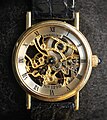Skeleton watch
A skeleton watch, also called a skeleton watch , is a watch that allows a glimpse into the movement . For this purpose, the clockwork is reduced by punching , sawing or milling so that cutouts are created that reveal the inside of the clock. Can be broken thereby the board , the bridges , the clamp and the spring property of the base station, and possibly also of the rotor only to the extent be ensured that the function and stability, The openwork clockwork is called a skeleton movement .
Description of the clock types
In the course of time there was an effort to skeletonize the watch in almost all watch types in order to gain insight into the movement. This usually requires a closing event of the movement. Here are just the most common skeleton types:
Table and wall clocks
The skeletonized table clock is a type of clock that has been manufactured in France since around 1750 and later also in England and Austria . Most of the time, table clocks of various designs were made, in which the movement is deliberately made clearly visible through the use of narrow and heavily perforated plates. Such watches are often under a glass cover . Skeletonized wall clocks ( regulators ) are also known. The dials were mostly reduced to narrow number rings. Skeletonized Stutzuhrs were in the 1st half of the 19th century. especially popular in France.
Pocket watches
There were also skeletonized pocket watches and those with an open dial . One of the most famous was made for Marie Antoinette by Abraham Louis Breguet . From the middle of the 19th century, pocket watches of this type were made by individual Swiss manufacturers.
Wrist watches
Skeletonized wristwatches have been available since around the mid-1930s. On the one hand, there are machine-made wristwatches of this type, which are usually simply processed. On the other hand, there are handcrafted skeleton watches, which are mainly found in the high-priced watch segment due to their time-consuming and complicated production. Some well-known watch manufacturers have such watches manufactured in small series. Hand-skeletonized wristwatch movements are often provided with a watch case back made of sapphire glass ( see-through back ) and, in the course of the finissage , with fine engravings or chasings on the work plate.
photos
Skeletonized table clock under a glass cover ( Baltimore Museum of Art )
Mechanically skeletonized
Sea-Gull ST16 movementHand-skeletonized wristwatch ( Breguet SA )
Figurative work plate (Three Bridges, Girard-Perregaux )
Openwork figurative work plate (latitude and longitude, Jaeger-LeCoultre )
literature
- FB Royer-Collard: Skeleton Clocks. NAG, London 1969
- Derek Roberts: Skeleton Clocks, Britain 1800–1914. Antique Collectors Club, 1987, ISBN 1851490590
- Derek Roberts: Continental and American Skeleton Clocks. Schiffer Pub Co, 1997, ISBN 978-0887401824
Web links
- Skeleton watch in UhrenLexikon
- Michael Dempsey: The Construction of a SKELETON Clock (PDF file; 1022 kB) FNAWCC (English)
Individual evidence
- ↑ Rudi Koch (Ed.): BI-Lexicon - clocks and time measurement. VEB Leipzig, 1986, ISBN 3-323-00100-1 , p. 194
- ↑ Skeleton watch in Illustrated specialist dictionary of watchmaking
- ^ Helmut Kahlert , Richard Mühe , Gisbert L. Brunner , Christian Pfeiffer-Belli: wrist watches: 100 years of development history. Callwey, Munich 1983; 5th edition, ibid 1996, ISBN 3-7667-1241-1 , p. 505.
- ↑ Skeleton clock (2) in UhrenLexikon
- ↑ Viktor Pröstler: Callweys manual of the clock types. From the wristwatch to the zappler. Callwey Munich 1994, ISBN 3-7667-1098-2 , p. 80
- ↑ Fritz von Osterhausen: Callweys lexicon. Munich 1999, ISBN 3-7667-1353-1 , p. 200
- ↑ Skeleton clock (1) in UhrenLexikon
- ^ Helmut Kahlert, Richard Mühe, Gisbert L. Brunner, Christian Pfeiffer-Belli: wrist watches: 100 years of development history. 1996, p. 505.





